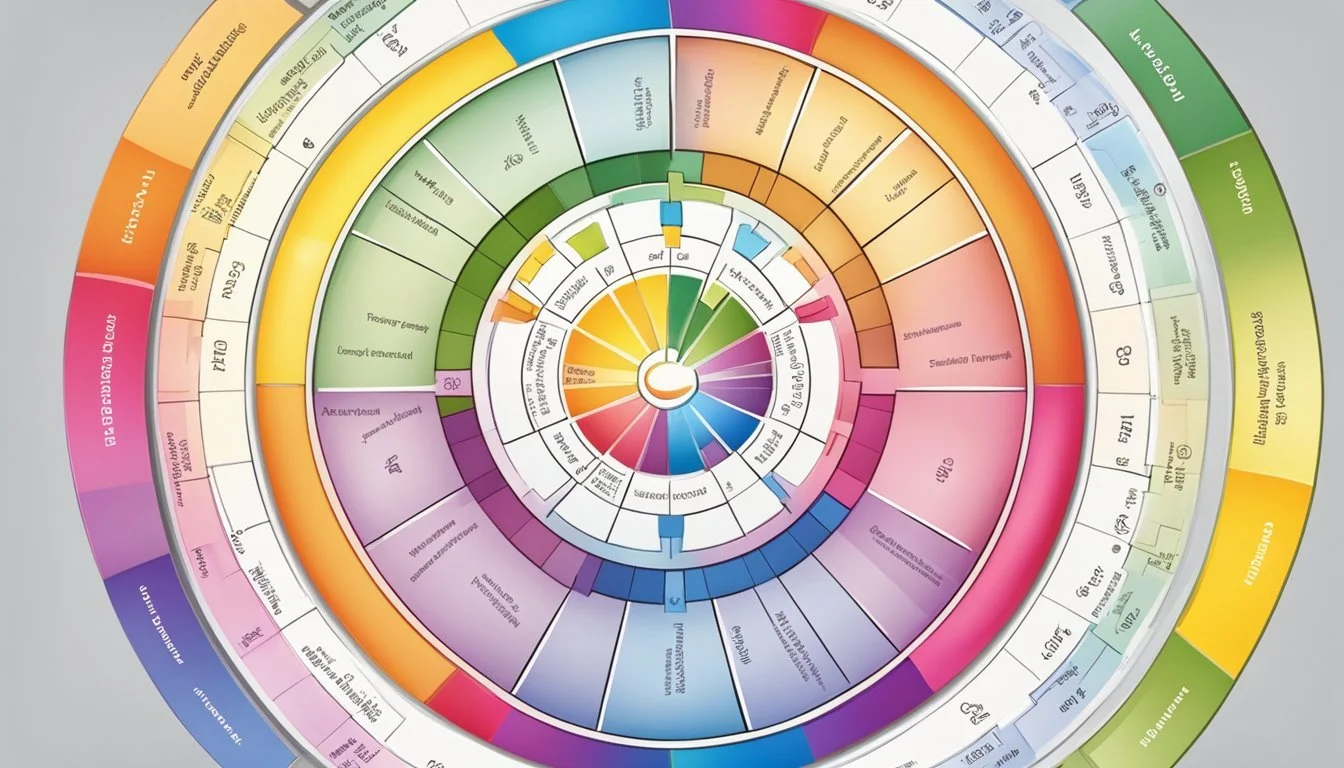10 Techniques to Enhance Your Emotional Self-Awareness
Practical Steps for Personal Growth
Emotional self-awareness forms the foundation of emotional intelligence, playing a crucial role in personal growth and interpersonal relationships. It involves recognizing and understanding one's own emotions, their triggers, and their impact on thoughts and behaviors. Developing emotional self-awareness can lead to improved decision-making, better stress management, and enhanced communication skills.
Individuals seeking to boost their emotional self-awareness have various techniques at their disposal. These methods range from simple daily practices to more structured approaches, all aimed at helping people gain deeper insights into their emotional landscape. By incorporating these techniques into their lives, individuals can cultivate a greater sense of self-understanding and emotional balance.
1) Journaling Daily Reflections
Journaling daily reflections is a powerful technique for enhancing emotional self-awareness. This practice involves setting aside time each day to write about one's thoughts, feelings, and experiences.
Regular journaling helps individuals process their emotions and gain clarity about their inner world. By putting pen to paper, people can explore their reactions to various situations and identify patterns in their emotional responses.
Many find it helpful to use prompts to guide their journaling practice. These can include questions about the day's events, current mood, or personal goals. Some may choose to focus on gratitude, listing things they appreciate each day.
The act of writing itself can be therapeutic, allowing for the release of pent-up emotions. It also creates a record that can be revisited, providing insights into personal growth over time.
Consistency is key when journaling for self-awareness. Even a few minutes each day can yield significant benefits. Some prefer to write in the morning to set intentions, while others find evening reflections more valuable.
2) Practicing Mindfulness Meditation
Mindfulness meditation is a powerful technique for enhancing emotional self-awareness. This practice involves focusing attention on the present moment without judgment.
Regular mindfulness meditation can help individuals become more attuned to their thoughts, feelings, and bodily sensations. It allows for a deeper understanding of emotional patterns and reactions.
To begin, find a quiet space and sit comfortably. Close your eyes and focus on your breath, noticing the sensation of air moving in and out of your body.
As thoughts arise, acknowledge them without getting caught up in their content. Gently redirect your attention back to your breath.
Start with short sessions of 5-10 minutes and gradually increase the duration as you become more comfortable with the practice. Consistency is key to reaping the benefits of mindfulness meditation.
Over time, this practice can lead to improved emotional regulation and a greater capacity to respond to challenging situations with clarity and composure.
3) Identifying and Naming Emotions
Recognizing and labeling emotions is a crucial skill for emotional self-awareness. This process involves paying attention to internal cues and external triggers that signal emotional states.
One effective technique is to pause throughout the day and check in with oneself. This allows individuals to notice their current feelings and name them accurately.
Expanding one's emotional vocabulary can greatly enhance this ability. Learning and using specific emotion words helps differentiate between subtle emotional states.
Keeping an emotion journal is another valuable practice. Writing down experiences and associated feelings helps track patterns and gain insights into emotional responses.
Physical sensations often accompany emotions. Noticing changes in heart rate, breathing, or muscle tension can provide clues about emotional states.
Mindfulness meditation can sharpen emotional awareness. Regular practice cultivates the ability to observe thoughts and feelings without judgment.
Seeking feedback from trusted friends or family members can offer external perspectives on one's emotional expressions and behaviors.
4) Exploring Emotional Triggers
Emotional triggers are specific stimuli that evoke strong emotional reactions. These can be external events, internal thoughts, or memories that spark intense feelings.
Identifying personal triggers is crucial for enhancing emotional self-awareness. Individuals can start by paying attention to situations that consistently elicit strong emotions.
Keeping a trigger journal can be helpful. People can record the events, thoughts, and physical sensations associated with their emotional responses.
Analyzing patterns in these records can reveal common themes or recurring triggers. This insight allows for better preparation and management of emotional reactions.
It's important to approach trigger exploration without judgment. Accepting that triggers exist and understanding their origins can lead to more effective coping strategies.
Seeking feedback from trusted friends or family members can provide additional perspectives on one's emotional triggers. They may notice patterns that are not immediately apparent to the individual.
Professional support, such as therapy, can offer guided exploration of complex triggers. Therapists can help uncover deep-rooted causes and develop tailored coping mechanisms.
5) Using Mood-Tracking Apps
Mood-tracking apps have become valuable tools for enhancing emotional self-awareness. These digital aids allow users to record their emotions throughout the day, providing insights into patterns and triggers.
Many apps offer simple interfaces with emoji-based mood selection, making it quick and easy to log feelings. Some popular options include Daylio, Moodfit, and Worry Watch.
Users can often add context to their mood entries by noting activities, sleep patterns, or other relevant factors. This additional information helps identify connections between daily experiences and emotional states.
Over time, these apps generate visualizations and reports that highlight trends in a person's emotional landscape. These data-driven insights can reveal recurring patterns or unexpected correlations.
Some mood-tracking apps incorporate features based on therapeutic techniques, offering coping strategies or relaxation exercises tailored to the user's recorded moods. This integration of tracking and support can be particularly beneficial for managing stress, anxiety, or depression.
By consistently using a mood-tracking app, individuals can develop a more nuanced understanding of their emotional responses. This increased awareness can lead to better emotional regulation and more informed discussions with mental health professionals.
6) Practicing Deep Breathing Techniques
Deep breathing is a powerful tool for enhancing emotional self-awareness. This technique helps individuals connect with their bodies and emotions in the present moment.
To practice deep breathing, one can start by finding a comfortable position, either lying down or sitting upright. Placing one hand on the chest and the other on the abdomen can help track breathing movements.
Inhaling slowly through the nose for a count of six seconds allows the lungs to fill completely. The abdomen should rise more than the chest during this process.
Exhaling gently for another six seconds helps release tension and promote relaxation. Maintaining an equal inhalation-exhalation ratio is key to maximizing the benefits of this exercise.
Repeating this cycle for a few minutes each day can significantly improve emotional awareness. As one focuses on their breath, they may notice physical sensations and emotions more clearly.
Incorporating deep breathing into daily routines can help manage stress, reduce anxiety, and improve overall emotional well-being. With regular practice, individuals may find it easier to recognize and process their emotions effectively.
7) Engaging in Open Dialogue
Engaging in open dialogue with others can significantly enhance emotional self-awareness. By sharing thoughts and feelings, individuals gain new perspectives on their emotional experiences.
Open conversations allow people to verbalize their emotions, helping them better understand and process their feelings. This act of expression can lead to increased clarity and self-reflection.
Listening to others' experiences and viewpoints can provide valuable insights into one's own emotional patterns. It creates opportunities for comparison and contrast, highlighting personal emotional tendencies.
Honest dialogue fosters a safe environment for exploring complex emotions. Individuals can discuss challenging feelings without fear of judgment, promoting deeper self-understanding.
Through open communication, people can receive feedback on their emotional expressions and behaviors. This external input can reveal blind spots in self-perception and emotional awareness.
Engaging in dialogue also exercises emotional vocabulary. Regularly discussing feelings helps expand one's ability to identify and articulate various emotional states.
Practice in open dialogue enhances overall emotional intelligence. It improves skills in recognizing, understanding, and managing emotions in both oneself and others.
8) Seeking Professional Therapy
Professional therapy offers a structured approach to enhancing emotional self-awareness. Trained therapists provide a safe, non-judgmental environment for individuals to explore their feelings and thoughts.
Therapy sessions can help uncover deep-seated emotions and patterns that may not be apparent through self-reflection alone. Therapists use various techniques to guide clients in identifying and understanding their emotional responses.
Cognitive-behavioral therapy (CBT) is particularly effective for improving emotional self-awareness. It focuses on the connection between thoughts, feelings, and behaviors, helping individuals recognize and change unhelpful patterns.
Other therapeutic approaches, such as psychodynamic therapy or mindfulness-based therapies, can also contribute to increased emotional self-awareness. These methods often involve exploring past experiences and their impact on current emotional states.
Regular therapy sessions provide an opportunity for ongoing self-discovery and growth. Therapists can offer valuable feedback and teach specific skills for recognizing and managing emotions in daily life.
Seeking professional help demonstrates a commitment to personal growth and emotional well-being. It can be especially beneficial for those struggling with complex emotional issues or past traumas.
9) Using Emotion Wheel Charts
Emotion wheel charts are valuable tools for enhancing emotional self-awareness. These visual aids display a range of emotions, typically arranged in a circular format.
The most common emotion wheel features eight primary emotions: joy, trust, fear, surprise, sadness, anticipation, anger, and disgust. These core emotions are often placed at the center of the wheel.
Surrounding the primary emotions are more nuanced feelings, allowing users to pinpoint their emotional states with greater precision. This helps individuals better understand and articulate their feelings.
To use an emotion wheel, start by identifying the primary emotion you're experiencing. Then, move outward on the wheel to find more specific descriptors that match your current state.
Regular use of emotion wheels can improve emotional vocabulary and help people recognize subtle differences between similar feelings. This increased awareness can lead to more effective emotional regulation and communication.
Emotion wheels can be particularly useful during therapy sessions, journaling exercises, or discussions about feelings with others. They provide a shared language for expressing complex emotional experiences.
10) Practicing Gratitude Exercises
Gratitude exercises can significantly enhance emotional self-awareness. These practices help individuals recognize and appreciate positive aspects of their lives, fostering a more balanced perspective.
One effective exercise is keeping a gratitude journal. Participants write down three things they're thankful for each day, encouraging them to notice and acknowledge positive experiences.
Another technique involves expressing gratitude to others. This can be done through writing thank-you notes or verbally expressing appreciation, promoting positive social connections and self-reflection.
Gratitude meditation is a powerful tool for cultivating awareness. Practitioners focus on things they're grateful for, allowing themselves to fully experience the associated positive emotions.
The "Three Good Things" exercise involves reflecting on three positive events at the end of each day. This practice helps shift focus towards positive experiences and emotions.
Gratitude walks provide an opportunity to combine mindfulness with appreciation. During these walks, individuals consciously notice and appreciate their surroundings.
These exercises can lead to increased self-awareness by highlighting positive emotions and experiences. Regular practice can help individuals develop a more nuanced understanding of their emotional states and reactions.
Understanding Emotional Self-Awareness
Emotional self-awareness forms the foundation for personal growth and effective interpersonal relationships. It involves recognizing and understanding one's own emotions, their causes, and their impact on thoughts and behaviors.
Definition and Importance
Emotional self-awareness refers to the ability to identify and comprehend one's own emotional states. It encompasses recognizing feelings as they arise, understanding their origins, and acknowledging their influence on actions and decisions. This skill plays a crucial role in personal development, stress management, and building meaningful connections with others.
Individuals with high emotional self-awareness can:
Accurately label their emotions
Identify emotional triggers
Recognize how emotions affect their performance
Make more informed choices
Developing this skill leads to improved emotional regulation, better decision-making, and enhanced overall well-being. It also fosters empathy and strengthens relationships by enabling individuals to communicate their feelings more effectively.
Psychological Foundations
The concept of emotional self-awareness is rooted in psychological theories of emotional intelligence and self-concept. It draws from cognitive psychology, which examines how people process and interpret information about themselves and their environments.
Key psychological components include:
Introspection: The ability to examine one's thoughts and feelings
Self-reflection: Analyzing personal experiences and their emotional impact
Metacognition: Thinking about one's own thought processes
Neurologically, emotional self-awareness involves the interplay between the prefrontal cortex, responsible for executive functions, and the limbic system, which generates emotions. This interaction allows for the conscious recognition and interpretation of emotional states.
Psychological research suggests that emotional self-awareness can be developed through practice and mindfulness techniques. Regular self-reflection exercises and emotional journaling can significantly improve this skill over time.
Barriers to Emotional Self-Awareness
Emotional self-awareness faces several obstacles that can hinder personal growth and understanding. These barriers stem from internal psychological factors and external societal influences.
Common Psychological Obstacles
Fear of vulnerability often prevents individuals from exploring their emotions deeply. Many people worry that acknowledging their feelings will expose weaknesses or lead to judgment from others. This fear can create a barrier to self-reflection and emotional growth.
Cognitive biases also play a role in limiting emotional self-awareness. Confirmation bias, for example, leads people to seek information that supports their existing beliefs while ignoring contradictory evidence. This can reinforce inaccurate perceptions of one's emotional state.
Avoidance behaviors frequently impede emotional self-awareness. Some individuals may distract themselves with work, social media, or other activities to avoid confronting uncomfortable emotions. This pattern can prevent the development of a deeper understanding of one's emotional landscape.
Overcoming Societal Norms
Cultural expectations often discourage open expression of emotions, particularly in certain societies or professional settings. This can lead to the suppression of feelings and a disconnection from one's emotional experiences.
Gender stereotypes persist in many cultures, dictating which emotions are acceptable for men and women to express. These norms can create internal conflicts and hinder the development of emotional self-awareness.
The fast-paced nature of modern life leaves little time for introspection. Many people prioritize productivity over emotional well-being, neglecting the importance of self-reflection and emotional growth.
Social media and digital communication can create a facade of constant happiness and success. This unrealistic portrayal of life can make it difficult for individuals to acknowledge and process their authentic emotions.




